French Bulldogs usually have short, coarse hair. However, there’s a recessive gene that can give them slightly longer, fluffier hair. This is known as the Fibroblast Growth Factor 5 (FGF) gene.
It is naturally present within the French Bulldog population, although the gene is rare. Since it is a recessive trait, both parents must carry the gene to give birth to a fluffy French Bulldog.
The following guide will provide you with vital information about this adorable breed. You’ll learn about their appearance, history, temperament, special care needs, and more.

What Does a Fluffy Frenchie Look Like?
Fluffy French Bulldogs are similar in appearance to regular Frenchies. They have a longer coat made up of longer, fluffier hair.
They are not considered the breed standard since most kennel club standards only allow the short-haired French Bulldogs to compete.
The fluffy Frenchie isn’t recognized by the American Kennel Club (AKC), Canadian Kennel Club (CKC), or United Kennel Club (UKC).
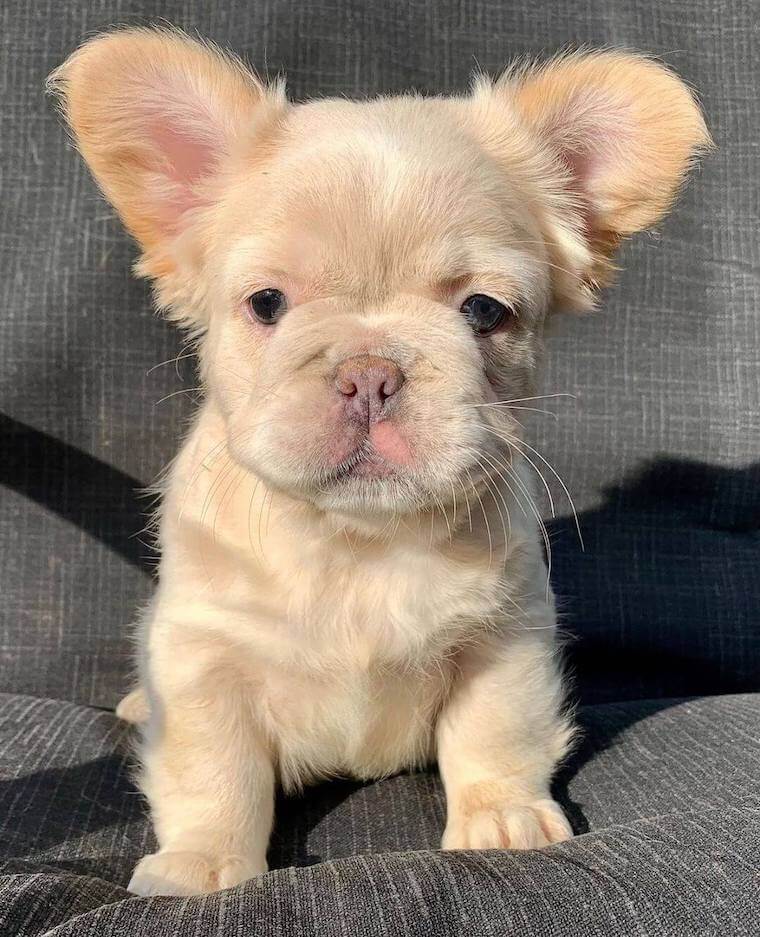
The French Bulldog breed cannot officially have long hair, even though purebred Frenchies can carry the gene. Even if a fluffy Frenchie is born to purebred parents, this variant isn’t recognized by these clubs!
Although they are described as “long-haired” Frenchies, the truth is that their hair is only longer when compared to the regular French Bulldog.
Their fur is most accurately described as medium-length. It is usually a bit fluffier around the dog’s chest, neck, and ears.
Besides the slight difference in coat, these dogs are strikingly similar to French Bulldogs. They are heavily boned, sturdy, and very compact dogs.
Although they are smaller than other dog breeds, they aren’t dainty little lap dogs. They have large, square-shaped heads and dark-colored eyes.
French Bulldogs are known for their “bat ears,” large ears that stand up straight on the tops of their heads. They also have short tails that are either straight or screwed. Their tails are never curly.
Fluffy French Bulldogs come in a wide range of colors, including fawn, white, brindle, cream, and blue. Rarer colors include lilac, blue and tan, chocolate and tan, and blue merle.
Veterinarians typically recommend that you have your fluffy Frenchie’s dewclaws removed. Since these claws don’t have a bone in them, they can get caught on things and pulled off easily.
See also: Meet the French Bulldog English Bulldog Mix

History of the Fluffy French Bulldog
There isn’t much published information available about when the long-haired gene initially appeared. It’s very likely that the long-haired variants have been around as long as the French Bulldog breed.
Some speculate that puppies with long hair may have been euthanized at one point because of their non-conformity to breed standards. With the increase in demand for fluffy pups, it’s unlikely that practice continues today.
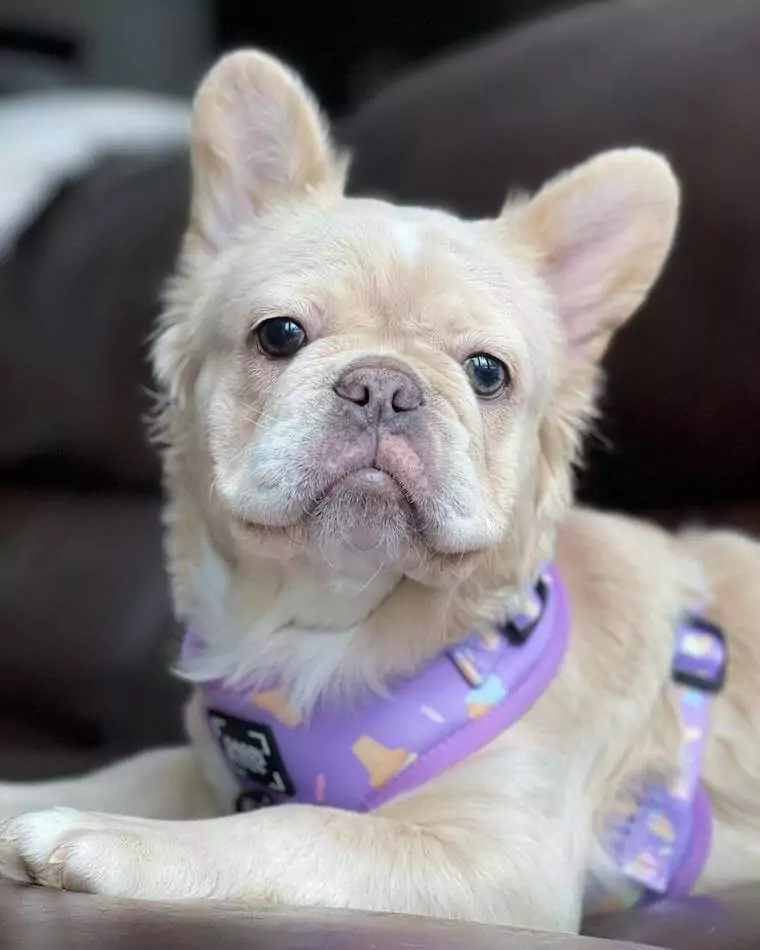
The French Bulldog breed was once used for bull-baiting in England. When the practice was outlawed in the early 1800s, people realized that the French Bulldogs had value as companion animals.
They were interbred with terriers to further decrease the breed’s size. The breed first appeared in kennel club dog shows in the 1860s and quickly became popular in France.
When breeders in England had dogs that were too small or had “bat ears,” they would send them to France to become companion dogs.
Over time, the French ended up with small dogs with erect ears. This toy bulldog breed then gained a new name: French Bulldog.
They quickly became high-fashion companion pets. The upper-class citizens of France were eager to get their hands on these dogs.
They were often seen in royal court, although their small size made them common in middle-class and working-class homes.
There are no real records of the breed’s development since the 1800s, although it’s likely that terrier stock has been added to increase the prevalence of erect ears.
While bat ears were once considered a fault, they are now a key part of the breed’s standard appearance.

Fluffy French Bulldog Personality and Temperament
Fluffy French Bulldogs make great companion animals because they’re very people-oriented. They love to be in close contact with people and hate being alone for any period of time.
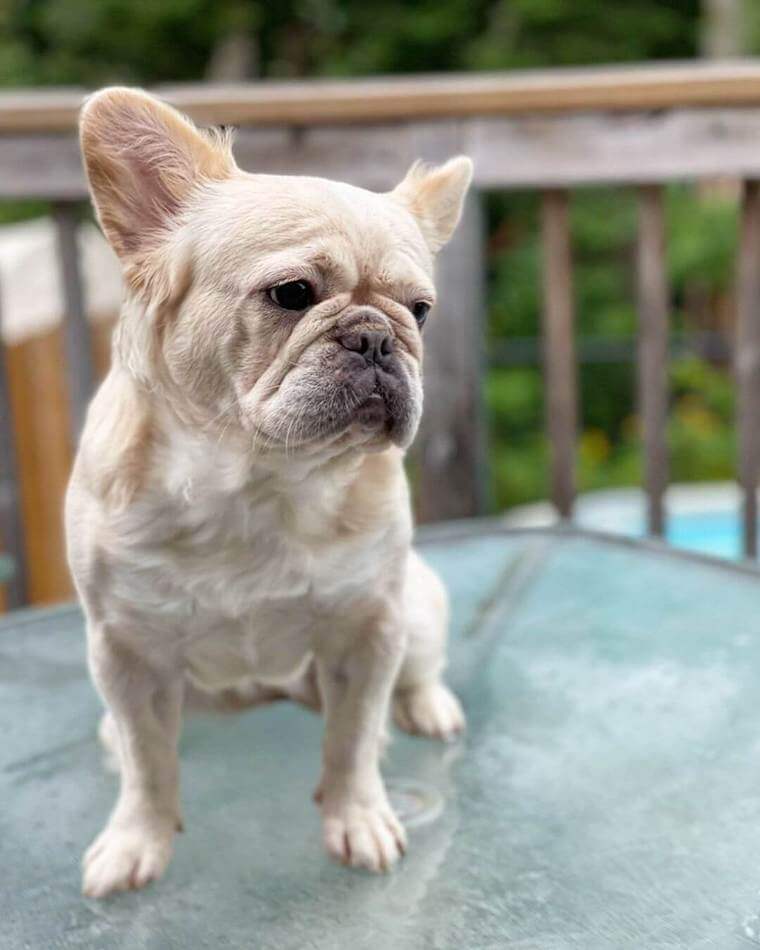
They are prone to separation anxiety, making them a poor choice for people who are rarely home. The puppies often struggle with anxiety. When untrained, anxiety problems can continue into adulthood.
Frenchies are not noisy dogs and rarely bark. Because of this, they aren’t good alert dogs.
They are often affectionate with their owners and get along well with other people. When well socialized, they make great companions to other dogs. They even get along well with cats!
Breed Training and Exercise Requirements for a Fluffy Frenchie
The training and exercise requirements of a fluffy Frenchie are the same as their regular Frenchie counterparts.
Because of their people-pleasing tendencies, they are easy to train. When compared with other dogs, they have average intelligence. They have enough intelligence to learn most commands.

Frenchies can be stubborn. Early socialization can help with stubbornness issues. Despite their stubborn streak, they are usually friendly.
As long as they’ve been properly socialized, they do great with other pets. Puppy training classes can help with basic commands and early socialization needs.
Unlike other breeds, Frenchies don’t need much exercise. Short, daily walks will be sufficient for their needs. Strenuous exercise can result in heavy breathing, which can be problematic due to breathing problems caused by their flat faces.

Fluffy Frenchie Health and Care
It’s really important to exercise to keep these dogs healthy. When overweight, Frenchies experience a number of health problems.
Because they’re not the healthiest breed to begin with, weight gain can make problems even worse. Obesity should be avoided at all costs. It’s important to feed Frenchies the appropriate amount of food for their age and needs.
Fluffy French Bulldogs love to run and play. Despite their stocky frames, they can excel in agility. It’s important to keep them active with short bursts of low-intensity activity.
Their short legs make it hard for them to swim for long periods of time. They should always be supervised around water.
Their heavy bodies and short legs make it nearly impossible for them to swim. Their flat face also makes it hard to keep their nose above water, increasing the risk of drowning.
Unfortunately, these dogs also love water, which means they may jump into water without being able to stay above it.
See also: Why Do French Bulldogs Sleep So Much? Is It Normal?
Common Fluffy Frenchie Health Issues
Fluffy French Bulldogs are prone to health problems. Responsible breeding practices can help prevent the continuation of poor genes within Frenchie’s bloodlines.
Reputable breeders will submit their dogs for health testing. Always request documentation from breeders before buying a fluffy Frenchie puppy.
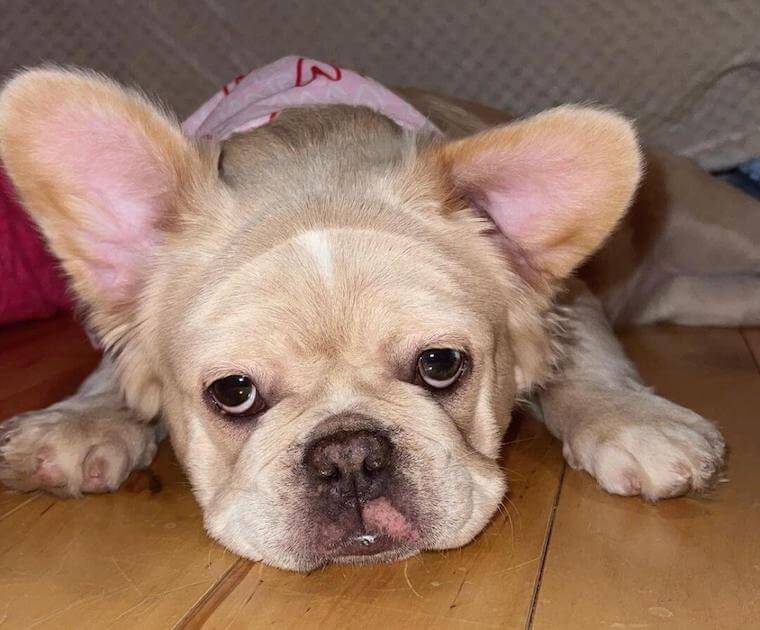
The following are some of the common French Bulldog health issues.
Brachycephalic Airway Obstruction Syndrome
Their squished face is caused by a deformation of their skull that’s been encouraged through years of breeding.
This deformation has led to Brachycephalic Airway Obstruction Syndrome, which can cause your Frenchie to snore loud because they can’t breathe properly.
Frenchies tire easily, which is why they pant with exercise. Because of their condition, you cannot leave your dog outside for too long or push too hard during exercise. Your dog may experience heat exhaustion or death when worked too hard.
This condition can be treated with expensive and invasive surgery. The surgery involves taking out a portion of your dog’s soft palate to increase the amount of air that reaches the lungs.
However, this surgery is only used if your Frenchie has experienced serious complications from their condition.
Temperature Regulation
Fluffy French Bulldogs cannot effectively regulate their body temperature. Even though they have a longer coat than other Frenchies, it isn’t enough to keep them warm in winter months.
In the summer months, they are prone to heatstroke and exhaustion. Humid weather can be particularly dangerous for French Bulldogs. Access to air conditioning is important for Frenchies living in hot climates.
It’s important to use special care during hot weather. Avoid overexerting your Frenchie. If he’s breathing too hard, it’s a sign that he’s having trouble breathing.
Make sure your Frenchie always has access to a cool space. If your Frenchie has to stay outside, hose them with cool water to help regulate their temperature.
Patella Issues
French Bulldogs are prone to patellar luxation, which is a dislocation of their kneecap.
Usually, your dog’s kneecap sits in front of the joint in their hind leg. It’s held in place by ligaments and slides around within a groove when your dog walks. This protects the joint without restricting movement.
However, patellar luxation occurs when the kneecap slips out of the groove and dislocates, moving freely around the knee.
When this problem isn’t treated, the floating bone can press against other bones and cause serious damage.
Reproductive Issues
Fluffy French Bulldogs have serious reproductive issues. They almost always require artificial insemination and C-sections in order to conceive and give birth.
This is mostly because Frenchies have small hips, making it impossible to mate or give birth without assistance.
Eye Problems
Frenchies are prone to a number of issues with their eyes, including cherry eye, glaucoma, corneal ulcers, and cataracts.
Cherry eye is a condition that causes your dog’s third eyelid to slide up into their eye. However, this is a problem that rarely causes any discomfort for your dog, even if it looks unappealing.
Skin Issues
Fluffy French Bulldogs are prone to skin problems. Since bacteria can grow in the folds of their skin, they’re more likely to have bacterial infections on their skin.
They may also develop skin allergies and eczema, with nearly 1 in 5 Frenchies developing some sort of medical skin problem.
Spinal Diseases
A number of spinal diseases impact the French Bulldog breed. Spinal cord compression and “butterfly vertebrae” are both conditions uncovered by x-rays and CT scans.
If a Frenchie has a “screw” tail, they are more likely to have spinal defects (since tails are an extension of the spine).

Grooming a Fluffy Frenchie
Even though fluffy French Bulldogs have longer hair than their standard counterparts, grooming them is still relatively easy.
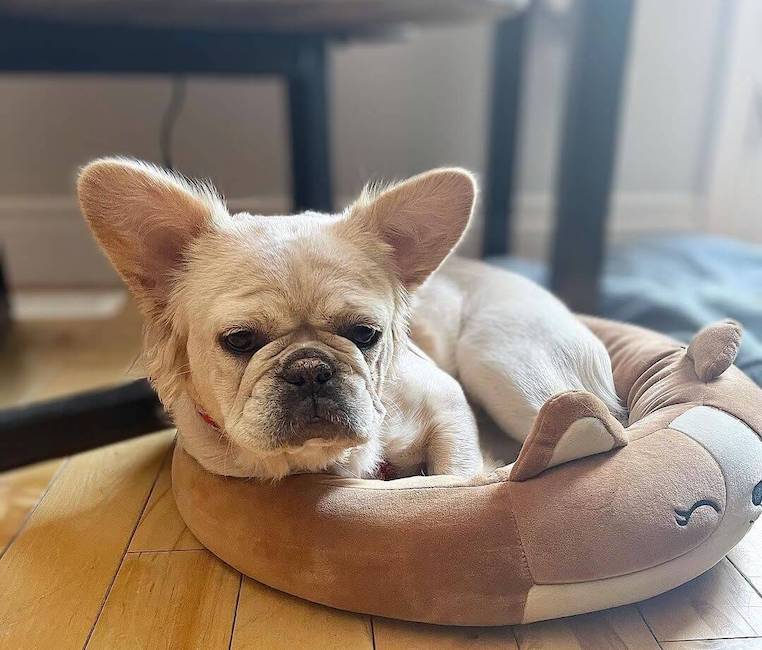
Since their hair doesn’t tangle, you can get away with brushing it only once a week. During shedding seasons, brush their hair more regularly to reduce shedding.
Their biggest grooming need has to do with the wrinkles and folds on their face and body. Since moisture in their folds can cause bacterial infections, they need to be cleaned and dried on a daily basis.
Fluffy Frenchies require occasional bathing, especially if they get dirty. Although they don’t need regular baths, bathing them can help remove dirt or debris. Whenever you bathe your Frenchie, it’s important to get them completely dry after their bath.
As with any dog, you should clean your Frenchie’s ears at least three times a month. However, if your Frenchie is prone to ear infections or has floppy ears that trap moisture and debris, you may need to clean their ears more frequently.
See also: How to Keep Your French Bulldog from Smelling (10 Tips)

Fluffy Frenchies & Dog Allergies
Fluffy French Bulldogs (and their short-haired counterparts) are not hypoallergenic. Because these dogs shed, their dander can cause an allergic reaction in people with dog allergies.
How Much Does a Fluffy Frenchie Cost?
As you probably already know, French Bulldogs are expensive, especially some of the rarer colors such as lilac or merle.
You can expect to spend at least $13,000 to buy a Fluffy Frenchie, depending on your location and the color you want.

Wrap-Up: Should You Get a Fluffy Frenchie?
Fluffy French Bulldogs are adorable. Because they are the result of a recessive genetic trait, they are often harder to find than their short-haired counterparts. Like regular French Bulldogs, fluffy Frenchies experience a number of medical conditions.
Before you bring one home, it’s important to be prepared to take care of them properly. With proper care, they can be excellent companions!
Photos courtesy: @missmarciamay
